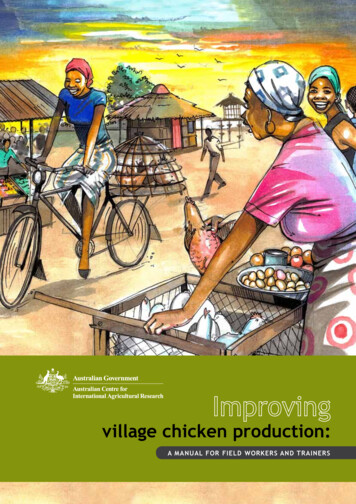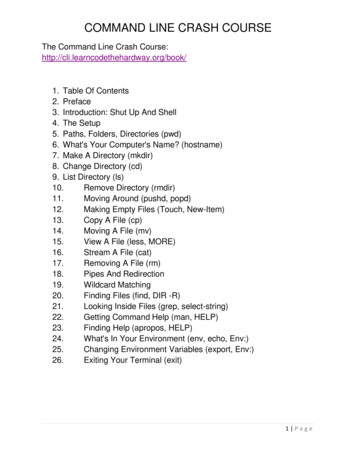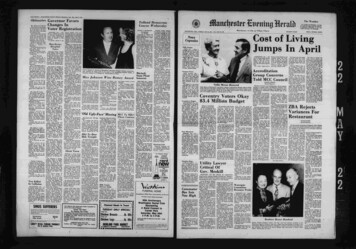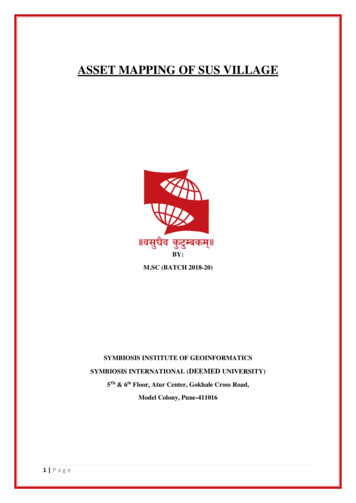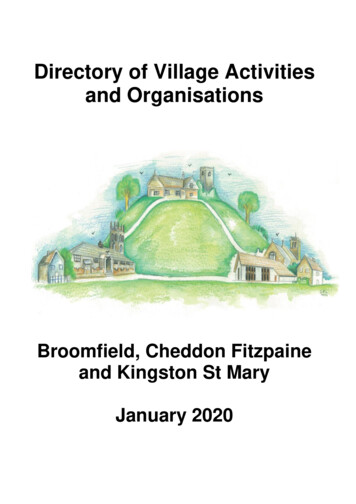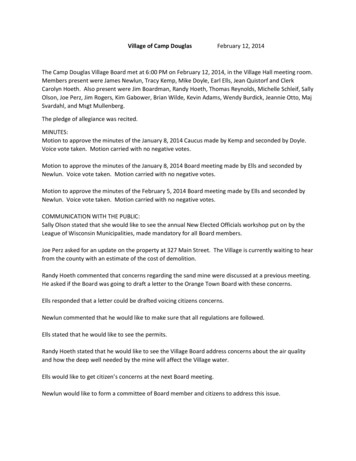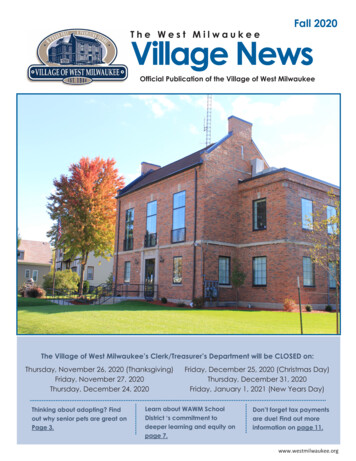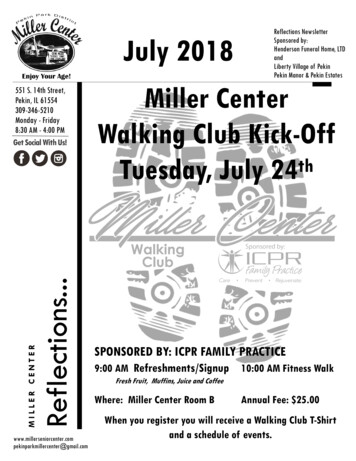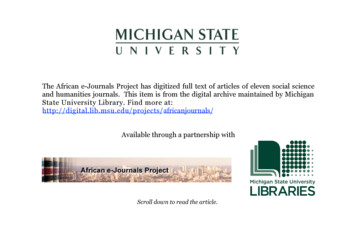
Transcription
The African e-Journals Project has digitized full text of articles of eleven social scienceand humanities journals. This item is from the digital archive maintained by MichiganState University Library. Find more nals/Available through a partnership withScroll down to read the article.
Pula: Botswana Journal of African Studies, vol. 13, nos. 1 & 2 (1999)The Zionist village of Lentswe-Ie-Moriti (1999)Cheneso MaphorisaThe Zion Christian Church was introduced in the Kgatleng as part of a political struggle, butquickly became a genuine religious body. Expelled from the Kgatleng in 1947, the Zionistssought a place of their own and in 1953 founded their own village at Lentswe-le-Montl. Despiteinitially difficult relations with neighbouring settler farmers, the village has established Itselfwhile preserving a strong religious identity. Relations with neighbouring BaBirwa have beencemented by the establishment of a state school in the village serving both communities. Thevillage has resisted attempts to assimilate it to more normal Botswana administration (forinstance by introducing a headman).IntroductionPresently there is available to the reader a number of books and articles on AfricanIndependent Churches (AICs) in Southern Africa. Bengt Sundkler's pioneering BantuProphets in South Africa (1948) laid the foundation on which almost all subsequentstudies have been built. 1 Sundkler distinguished between Zionist and Ethiopian typesof Independent churches. Ethiopian churches only stressed the Africanisation of theleadership of the church and not the Africanisation of its ritual and theology. On theother hand the Zionist churches stressed the work of the Holy Spirit (in healing,prophecy, dreams and visions) which accommodated traditional African culture andreligion. Sundkler's approach inspired scholars to debate the aspect of the causes of theproliferation of AICs. He himself asserted that 'independency' especially Zionism hasto be seen as an organised Black reaction to White political dominance.2 This assertioncan no longer explain the growth of the contemporary religious movements inSouthern Africa. Recent studies have shown that radical changes have occurred in thecultural environment within which the independent church movement used to be3situated. This explains why some scholars view Zionism as a collective response tourban poverty. And not only has colonialism disappeared, but also we have seen inSouth Africa itself the official demise of the apartheid system which used to be seen asa major causal factor for the rise of break-away churches.4Much has also been written about the persecution of AICs including their leaders.These people and their followers had to migrate from place to place and were often5arrested by colonial rulers. Consequently, some churches have founded their own newvillages as Isiah Shembe's Ekuphukamene and Engenas Lekganyane's Zion City6Morija in South Africa. This also happened in Zambia where the Jehovah's Witnessesreligious movement persuaded people to set up independent settlements at farms.7 Thepeople decided to live without recognised headmen. The establishment of Africanreligious villages may, in this respect, be interpreted as one of the aims of formingAICs. This means that the formation of these churches is also based on cultural factorsrather. than sim l o ra ial conflict. Hence James Amanze says that Africans need toexpenence ChristianIty ill the context of African culture.8 Amanze follows the viewthat AICs also exist in their own right as Christian missions that have responded to theca l.of God. He argues that in Botswana, their formation and spread is attributed tospIn al h ger and social factors which include faith healing, prophecy, worshippingGod ill African ways and preserving certain aspects of Tswana culture.108
Another theme, which has widely captured the attention of many writers, is theincreasing portance of ,:omen:s public r le in .reli ious. activities. Jules-Rosette'sbook contams comprehensIVe artlcles on thiS subject, notIng that women and theirministry have always been in the forefront in the AICs. But there is little analysisprovided to explain why women are often excluded from senior positions ofleadership. Fortlmately, R.J.Cazziol has recently attempted to fill this research gap. toHis paper inquires into the reasons why women are often excluded from seniorpositions whereas the strength of most AICs comes from their membership. Cazziolargues that in Swaziland, for instance, opposition to the ordination of women is notexclusively male. Many women oppose it as well.No doubt these approaches are crucial in our current understanding andinterpretation of Ales. But it is also crucial that anthropologists, sociologists, andhistorians particularly should conduct studies of AIC villages. To date, something hasbeen done on Tswana Christian villages. Paul Landau's book, which deals with themain northern Tswana polity of Ngwato, is an outstanding addition to literature onChristianity among the Tswana. I I It gives us one of the best case studies of a Christianvillage. The focus is on Lerala village in the Tswapong hills. Lerala's Christianity hassuccumbed to the growth of break-away churches since the latter 1940s. Landau agreesthat it would be wrong to depict this late twentieth-century proliferation of AICs onlyas a process in which Africans rid themselves from white Missionary control. HeaffIrms that Spiritual communities of AICs offer a place of "belonging," and help todefme their members' sense of identity. Landau also gives close attention to thedistinctive role of women in these churches.However, it must come as a surprise to readers that there are very few published orunpublished studies on villages specifically founded and controlled by religiouscommunities. Research work that gave birth to this study has discovered only onestudy of an AIC village in Zimbabwe. This is the Vapostori village whose historicalorigin and development is somewhat similar to the village the present studydiscusses.12 The study of the Metlobo settlement in the Ngwaketse District ofBotswana does not provide a suffIcient case study of an AIC village, though it is auseful pioneering study. 13.The present study is a detailed history of the Zionist village of Lentswe-le-Moritiin Eastern Botswana. Lentswe-le-Moriti, which is also a farm, is situated in thenorthern comer of the Tuli Block farms which until independence were largely whiteowned. This farm is one of the earliest farms to be bought in the Tuli Block byAfricans during the colonial period. It is adjacent to where the Limpopo/MotloutsiRiver divides the Transvaal in South Africa and Botswana. Mashathu Game Reserve,Talana farms and the Tuli Lodge are situated next to the village. This village remains aneglected area of study despite its uniqueness which serves as a 'living testimony' of ahistory of a bitter relation between religion and the state in the then BechuanalandProtectorate. Today this relationship has improved, but it is still crucial to the future ofthis village in more ways than one .Scanty but useful material on Lentswe-le-Moriti is found in the Botswana.NatIo.nalArchives in the form of colonial correspondence and reports. Unfortunatel It depiCtsthe Zionist settlement in a somewhat obscure and sketchy manner. It mcorrectlyassumes that 'Zionists at Lentswe-Ie-Moriti are exclusively Bakgatla who moved fromMochudi.'14 Many scholars who in their studies ment o.nL.entswe- e-Moriti.inpassingalso hold this mistaken view. Yet there are other famIlIes m the Village which e n?tKgatla by origin. The archival material is useful though it leaves much to be deSIred m109
the history of Lentswe-le-Moriti especially the events between 1966 and 1980. It mustbe noted that in writing this paper some important archival infonnation may have beenmissed. Authentic sources state that there are some missing files on the subject, whichhave been pulled out by government since independence. The possible reason is thatthey may be carrying delicate information since Zionism was considered a subverSIvemovement in the colonial period .Literature provided by scholarship on the history of Eastern Botswana and the TuhBlock in particular, only focuses on other subjects thereby making the history of theZionists a neglected area of scholarly investigation.IS The scholars generally discussthe proximity of the Bobirwa region to the Tub Block farms as indispensable in theeconomic enterprise of eastern Botswana. As such, they emphasise issues of labourrecruitment! provision, labour conditions and reasons explaining why people boughtfarms in the Tuli Block. The general agreement is that freehold farms were bought forcrop production, cattle industry and game hunting. Those who have studied the historyofBabirwa, Sekgwama in particular, focus on the socio-economic and political impactof the Ngwato rule on Babirwa after they were effectively incorporated into the16Ngwato State in 1920. Sekgwama notes some of the activities of missionaryChristianity among the Babirwa which followed this conquest (female initiation, malecircumcision and some aspects of the Birwa traditional religion were abolished).Landau also adds to this point by arguing that in Bobonong, laws such as theprohibition of Tswana beer, marriage rules, and hut taxes were taken seriously andwere enforced by Modisaotsile.17 Sekgwama himself neglects the fact that after 1960,many Babirwa who stay next to Lentswe-Ie-Moriti started to join Zionism andabandoned the London Missionary Society. It is this new religion which is explained inthis paper because of the contrasts that it brought in the region.This paper is a departure from the earlier works in that it clarifies the fact thatthere is a farm in Tuli Block which was bought for religious rather than farmingpurposes. It is also a departure from the tendency to explain the events that precededthe eventual occupation of Lentswe-Ie-Moriti.18 The study treats 1953 as a crucial datebecause it marked a turning point in the history of the Zionists in Bobirwa/ Tuli Blockarea. Its impact among Babirwa is also a factor that this study takes into seriousconsideration.In field work, a survey was carried out for at least nine weeks and 48 people wereinterviewed. An open ended questionnaire was administered each time a respondent orgroup f respondents was interviewed. The questionnaire carried questions concerningthe SOClo-economicand political aspects of Lentswe-Ie-Moriti. Sometimes respondentswere visited more than once to verify certain issues. It is likely that some inf0f!Ilationwas concealed because some things can only be said after the approval of EngenasLekganyane, the bishop of the Church in South Africa. Most selected respondents weremembers of the original Zionist expedition to Lentswe-Ie-Moriti. Hence the knowledgethey. shared is invaluable to the production of this study. The Zionists themselvesdommated the sample size but interviews in Ramotswa and Mochudi were also carriedout to determine the factors that led to the Zionists' expedition. Babirwa living near entswe- e-M riti w re. interviewed to determine their relationship to the Zionistssm e then: arnval. ZlODlStmigrant workers (they were reached through referrals bytheIT relatIv s), a few government officials, and workers in the village were eitherformally or mfonnally interviewed.This study has been divided into four parts. It is concerned mainly with the periodbetween 1953 and 1980. The fITstis an appraisal of the politics of the establishment of110
the Zion Christian Church (ZCC) in Bechuanaland Protectorate. This part analyses thepolitico-religious dynamics which were to form the basis of the subsequent emergenceof Lentswe-le-Moriti. The second part traces the interaction and conflict that followedthe arrival of Zionists in Bobirwa/Tuli Block area. It includes an assessmentconcerning provision of labour for both the Babirwa and the Boer farmers by theZionists, competition over wildlife, and survival in a new territory.The object of the third part is to explore the origin, obstacles and role of thedevelopment of Lentswe-le-Moriti school. The transformation of this school from aprivate one into a state school is closely examined. This part will shed light on whatmay be treated as the social consequences of the evolution of Lentswe-le-Moriti schoolin Eastern Botswana. The fourth and fmal part will focus on issues characterising postindependence developments in Lentswe-le-Moriti. Attention will be paid to theelections of 1965, the impact of independence and socio-political changes thatoccurred with particular reference to the Zionists. The fourth part ends by investigatingquestions that surround the absence of bogosi (headmanship). It also attempts to givereasons explaining the lack of development activities in the village. The year 1980 isthis study's terminal date because it marked a break of debate between government andZionists on the issue of bogosi.The establishment of the ZCC in the ProtectorateReligion and politics in the history of Botswana is the thrust of this chapter. It beginsby tracing the origins and growth of the ZCC in the Bechuanaland Protectorate. Theaim is to show how Tswana dikgosi (Chiefs), the colonial administration, themissionaries and the ZCC inter-acted particularly in Mochudi. The Chapter examinesthe sources of opposition to the establishment of the Church and of course otherAfrican Independent Churches in general. It will be established that the dikgosi andmissionaries were opposed to the ZCc. The colonial administration also allowed thedikgosi to persecute the ZCC thereby hindering the growth and spread of anyIndependent church in the country. The chapter ends by showing how Mazioni(Zionists) after experiencing persecution and banishment from the 'Reserves', finallyacquired a farm in the Tuli Block.19 This is the farm, which became their permanenthome. It will be pointed out that the problems involved in the acquisition of this farmcan be best understood against the background of the land policies of the time, whichfavoured Europeans at the expense of Africans.Bishop Engenas Barnabas Lekganyane of Pietersburg in South Africa started theZCC in 1924. It then grew into Botswana during the latter part of the 1930s. The sp k,which gave rise to the Church in Bechuanaland Protectorate, was lit by the suspensionof kgosi (Chief) Molefi by the administration. The Dutch Reformed Church (DRC) hadinfluenced the administration to take this action. And the supporters of the newreligion were against Isang, the new kgosi. In 1937 Zionism therefore started inMochudi as a 'political movement' -called Ipe/egeng-a gto sec re Molefi'sreinstatement as KgatJa kgosi.20 In 1938 the Ipe/egengchanged .Itsappell on to that ofthe ZCC in order to pursue its political intrigues under the guise o rehglon. lefalaMotsisi, a former migrant labourer in South Africa, and Bogatsu Dmtwe received theblessing of the leader of the Zion Christian Church, Lekga.nyane to start a ZC congregation. Upon its inception, some royalist members. clu mg Moh gadlSeingwaeng, Molefi's mother, and BakgatJa Pilane, his uncle, Jomed It. BakgatJa Pdanewas later to become minister of the congregation following the death of Rev. Motsl 1Ralefala in 1945. Morton afftrms that though Seingwaeng could not occupy thiS111
position, she still was a pillar of Zionism.2\ It seems that the involvement of someroyal members attracted a larger following among the Bakgatla .The establishment of the ZCC in Mochudi was apparently a dIrect OpposIte of theinception of the Ethiopian church in Kanye which was 'used as a vehicle for opposingthe ruling kgosi Bathoen,?2 While the former agitated for the reinstatement of the kgosithe latter conversely argued for the removal of the then traditional leadership. The onlysimilarity is that each of these parties involved some members of the ruling dynasty. Itis perhaps more against this background of political intrigues within these TswanaChiefdoms that one may justly reject the conventional wisdom that anti-white and'Africa for the Africans' feelings are universal grounds for the formation ofIndependent churches. In Lubinda's words Tswana cases were linked up withtraditional politics and the element of White-black confrontation is secondary.23 Thereason may be that in Botswana there were not many whites as was the case incountries like South Africa and Zimbabwe. As already stated at the outset, Sundkler'sgeneralisation to the effect that the racial issue is at the centre of Zionist and EthiopianChurches formation is therefore not the only factor.The formation of the ZCC in Kgatleng comparatively differed with the formationof the Church elsewhere in the protectorate. Among other Tswana ethnic groups theChurch was formed independently of royalist politics.24 By and large the Church cametlrrough poor migrant labourers who learnt of it in South Africa where it originated. Itthen grew because of the healing service it rendered. In light of this evidence it is mostlikely that in most chiefdoms the origin of the church was largely apolitical. Both thewhite-black confrontation and the struggle between the administration and the dikgosidid not prompt the birth of the Church. It was therefore only in the wake of theChurch's inception that the administration and the dikgoSI'S influence came to the fore.The establishment of AICs was generally not appealing to the polities of the time.In fact the laws of the country did not provide for the registration of Independentchurches.25 There was consequently a countrywide protest against Zionism by severaldikgosi who felt Zionists defied their authority. For example, kgosi Kgari Sechele whowas installed in 1935 by the British against the Bakwena's wishes was disturbed by thegrowing interest in Independent churches, especially the ZCe.26 The reaction ofBakwena towards the administration was very similar to that of the Bakgatla whosekgosi Molefi was deposed in 1937 by the administration for various administrativewrongs. As such, those candidates for bogosi who the administration installed were notalways accepted by their subjects. This always polarised Tswana chiefdoms. Thepolarity resulted in political factions comprising individuals who shared a commoninterest, ideology, or relationship to other individuals as was typified in the case ofKgatla Zionism.27In Kanye and of course Mochudi, the dikgosi opposed the ZCC by arguing that theZionists divided their people and did not attend tribal duties. There was also an outcryagainst the general refusal of the AICs to allow their members to consult westerndoctors and attend medical hospitals. This was not peculiar to Bechuanaland. InZululand, for instance, chiefs also believed that Zionists disturbed the community life28of the tribe. It would appear that the Bechuanaland Protectorate administration alsofrowned at the ZCe. Traditional leadership was effectively used by the colonialadministration to thwart the development of AICs. The ZCC was conceived as achallenge to the administration, especially as its establishment in Mochudi waspremised on challenging the decision of the administration. Jean Comaroff also argues112
that t e ability to win a population of multitudes across South Africa by the ZCCeven Iffor bona fide religious purposes-was extremely threatening to the state.29The Mission Churches were also not happy with Zionism in Bechuanaland. Theyviewed AICs with serious hostility. They also influenced the dikgosi and theadministration to take measures against these churches. Their argument, particularlyamong the Bakwena and Bakgatla, was based on the feeling that the ZCC poachedtheir membership. However people voluntarily joined Zionism. After the SecondWorld War, Mission Churches therefore increasingly lost members to the Zionists.30The tendency to repulse AICs
The Zion Christian Church was introduced in the Kgatleng aspart of apolitical struggle, but quickly became a genuine religious body. Expelled from the Kgatleng in 1947, the Zionists sought aplace oftheir own and in 1
